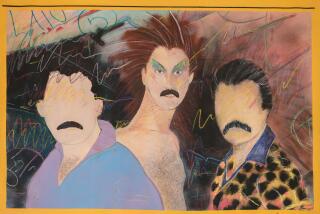Adrian Saxe’s ceramics put a twist on bar codes
Adrian Saxe is a ceramic artist known for juxtaposing the Historic and the Now with a trippy sense of humor. His latest musings in the show “GRIN — Genetic Robotic Information Nano,” at Frank Lloyd Gallery through Jan. 7, incorporate Quick Response (QR) codes, or the square bar codes, into sculpture that emulate antique Chinese vases and scholar’s rocks — rocks collected for their unusual and evocative forms.
“Made to seduce and then betray, Saxe’s elegant vessels present provocative concepts,” curator Martha Drexler Lynn wrote for his 1993 retrospective at LACMA, “The Clay Art of Adrian Saxe.” “While modeled on historical artworks, they are frequently spiced with allusions to popular culture.”
That trickster spirit abounds in his new work as well. “This one is called ‘Outback Cathedral,’” says Saxe, 58, professor of ceramics at UCLA. “It’s a reference to termite mounds.”
Shaped like a table-sized scholar’s rock, its golden crags are topped by a small pole with a QR suspended from the side like a small flag. He holds up his iPad to scan the code. Suddenly a photo of a termite hill in Australia pops onto screen. The other side of the flag kicks off a video — a dawn-to-dusk, time-lapse video of a termite hill in Brazil.
“These particular termites are like fireflies, so they glow all night long,” he says. As night falls, spots of bright green begin to flicker from the hill — a green reiterated by small green rhinestones Saxe set into his sculpture.
The Web-based images tied to the QRs are riffs of Saxe’s percolating brain. Some are whimsical, like “Outback Cathedral” or “Welcome Stranger,” which has a miniature Fred Astaire dancing and singing along the top ledge of the miniature mountain. “I love those old Fred Astaire movies,” the artist says.
Others have been processed more intellectually, such as “Holy Trinity — Fat, Salt, Sugar,” which takes the form of a tubular vase with S-shaped handles. Three Chinese characters (oil, salt and sugar) are vertically mounted on one side, with three corresponding QRs on the other side. The top QR links to a tempting photo of golden potato chips, the middle one to a Benvenuto Cellini salt cellar, and the bottom one to a big, lollipop. “That’s been a theme I’ve been thinking about for years,” Saxe says, “what’s killing everyone is what everyone craves.”
He found the images and videos online, “cleaning them up” and getting rid of advertising. The bar codes were obtained from a subscription service. Each of the six QR pieces is mounted on its own antique wooden base, which he has collected from shops and garage sales.
Perhaps Saxe’s fondness for combining the old and the new, as well as high culture and low culture, can be traced to his childhood. Born in Glendale, he grew up with a mother who was a cel colorist for Disney Studio, and a father who was an embalmer at Forest Lawn Mortuary. (Later Mr. Saxe made a living running a photography studio, while Mrs. Saxe helped with retouching the photos by hand, in the days before digital retouching.)
He began his work with ceramics in high school. Entering Chouinard Art Institute in 1965, Saxe continued studying ceramics under the influential Ralph Bacerra. He worked part-time for the Franciscan Group at Interpace in Glendale, where he learned commercial production methods.
Sometime during those early years he became fascinated by Chinese ceramics, especially that of the Sung Dynasty, and by 18th century European decorative arts. In his work, he says, “I was mimicking historic styles — to explore them.” He readily admits that to make ends meet, he produced a multitude of standard utilitarian objects, like cups, bowls, and plates. “Over the years I figure I’ve must have made 10,000 mugs.”
Contemporary art movements did not escape his attention. The front and side galleries of the current show include several gleaming bullet-shaped works with rather phallic references from the late ‘60s — they play on Finish Fetish in their high-gloss finish and to Funk in their irreverence. Also here are three newer works in the shape of pot stills, vessels used to distill liquor, which have been decorated with colorful flowers.
While QR art shows have been popping up here and there, few artists of Saxe’s reputation have taken it on. Right now, the bar code labels are direct print-outs and glued in place, but Saxe is already thinking of future projects where the code will be fired in — such perhaps a large platter linked to an airport map or tile murals inspired and linked to the works of early abstractions of Ellsworth Kelly.
“Pottery is both abstract and concrete,” Saxe says, “and it can carry all kinds of information which can be expressive, emotional or didactic or all those things. That’s the arena I work with.”
More to Read
The biggest entertainment stories
Get our big stories about Hollywood, film, television, music, arts, culture and more right in your inbox as soon as they publish.
You may occasionally receive promotional content from the Los Angeles Times.






